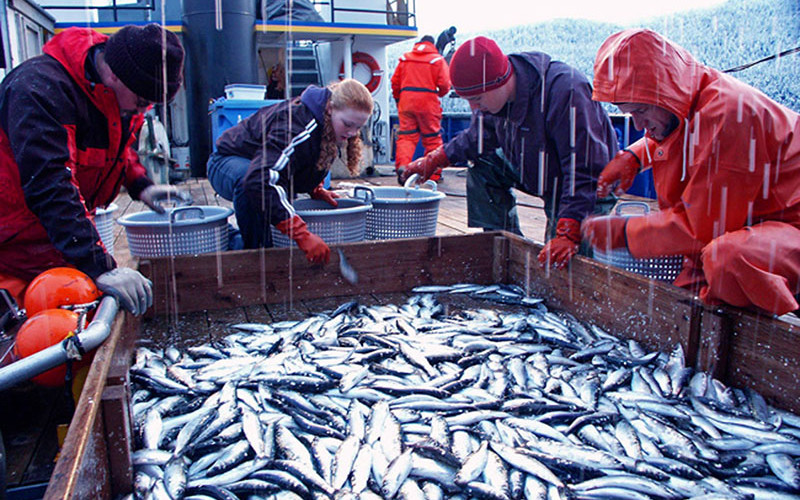The Alaska Department of Fish and Game (ADF&G) has posted a harvest guideline for the 2024 Sitka herring season of 81,246 tons, or approximately 162.5 million pounds.
“[The forecast] is greater than any prior forecast or estimate of spawning biomass for Sitka Sound herring,” ADF&G said in a 22 December advisory announcement.
But with few interested buyers, the fishery, which opens in late March or early April, is not attracting much commercial interest.
There are three herring fisheries in Alaska – Sitka; Togiak, which is in Bristol Bay; and Kodiak – all of which have experienced historically large runs in recent years. The forecast for the 2024 Togiak fishery is 216,037 tons, the fifth-highest since 1993. The 2024 Kodiak season forecast has not yet been released.
In 2022, the herring fishery was valued at $12.7 million, the highest value total since 2013 but down from previous years, during which the fishery regularly brought in between $20 million and $25 million in annual value. The all-time high in annual value for the fishery was $60.8 million in 1996.
While some herring is sold as bait, most of the fishery’s value is derived from roe, which is sold mainly to Japanese buyers. However, a continued lack of buying interest will likely result in a far lower harvest in 2024, and millions of pounds of herring will once again be ground up and dumped, according to Alaska Fish News. ADF&G Fishery Manager Tim Sands previously said there has been a decline in interest since the covid-19 pandemic began, with the number of processors buying herring dropping to one in 2022.
Just 11,000 tons (24.2 million pounds) of the 30,124-ton (60.3-million-pound) catch limit was landed in the Sitka fishery in 2023, with fishermen receiving $300 per ton for their catch. The Togiak fishery was canceled outright, and Kodiak fishery recorded a catch well under its harvest guidance.
The Alaska Seafood Marketing Institute (ASMI) has worked to increase demand for herring in the U.S. through its Alaska Herring Market Recovery Project, but ASMI Food Aid Program and Development Director Bruce Schactler said a management change is necessary. Currently, the spring fishery is designed to capture sac roe from spawning herring, but a fall fishery would deliver fish with higher oil content, he said.
“If you don’t change … management, then you don’t have access to those fish for those particular products that you’re going to try to address in some section of the market,” he told Alaska Public Media in April 2023. “Management has to change if anything else is going to change in any significant manner.”
Schactler is a supporter of Proposition 57, which will be considered by the Alaska Board of Fisheries at its upcoming meeting from Jan. 9-12. The proposal would create a second herring fishing season in the fall, targeting fattened herring that have fed for five to six months past spawning.
"Most of the allowed biological herring harvest in Alaska will once again go unharvested in 2024 due to the failing market for 'roe herring' that has been the case for many years now. From initial quota suggestions from ADF&G, the unharvested portion will likely be over 100,000 tons! It is unclear at his time if any of the roe herring quota in Kodiak will be purchased," he wrote in a public comment submitted to the board. "The need to diversify and bring new value to the herring fishery cannot be understated. New product made from herring – be it canned, pickled, or smoked – requires higher fat and/or better nutrition profiles."
Schactler said competing herring fisheries in Europe are in decline and that Alaska's herring fishery is undergoing the process of obtaining Responsible Fisheries Management (RFM) sustainability certification.
"This certification will put wild Alaska herring firmly in play as a preferred raw product for the retail markets that demand such certification," he said.
Alaska's herring fishery management system recently faced a challenge from the Sitka Tribe, which sued the ADF&G and the Alaska Board of Fisheries in 2018, alleging mismanagement was resulting in poor subsistence harvests of herring eggs. The claim was rejected by the Alaska Supreme Court on 2 January 2024, which ruled there had been no violation of a rule in Alaska's Constitution calling for a “sustained yield.”
“ADF&G takes our constitutional mandate to manage “consistent with sustained yield principle” as our cornerstone," ADF&G Commissioner Doug Vincent-Lang said in a press release.
This story originally appeared on SeafoodSource.com and is republished here with permission.







